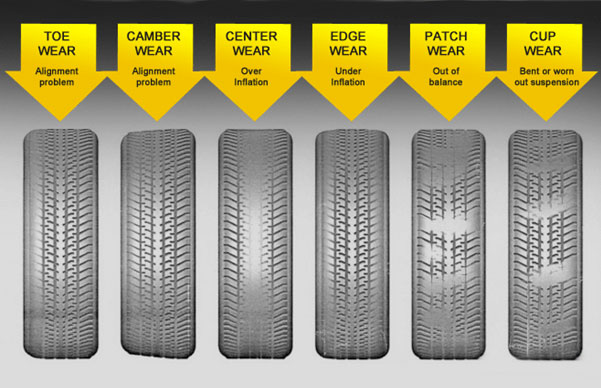
If driving down a highway requires your steering wheel to be turned at a crazy angle, it may be time for an alignment check. Proper alignment makes driving safer, more comfortable, and less expensive. In this article we will discuss alignments and how they affect your vehicle.
Alignment refers to the relationship of your wheels to each other and the vehicle. Over time, wheels can slowly move out of position due to wear, impacts with potholes, rough driving, and even accidents. As this happens, you'll notice some irregularities in your vehicle's operation and handling.
The drift test
 When you're driving down a flat, level road, take your hands off the wheel for a second (with no other vehicles near you and not at high speed, of course). If the vehicle continues to drive straight, your alignment is in good shape. If it starts drifting to the right or left, then your alignment needs some attention. If you're unfortunate enough to have to fight against your vehicle trying to make an undesired turn, then you need to fix your alignment immediately!
When you're driving down a flat, level road, take your hands off the wheel for a second (with no other vehicles near you and not at high speed, of course). If the vehicle continues to drive straight, your alignment is in good shape. If it starts drifting to the right or left, then your alignment needs some attention. If you're unfortunate enough to have to fight against your vehicle trying to make an undesired turn, then you need to fix your alignment immediately!
This simple test is just one of many that can provide vital information about your wheel alignment. Other signs that something is not lined up properly include vibrations, a steering wheel that is not straight even when the car is not turning, poor shock performance when hitting potholes, and reduced fuel economy.
Understanding wear patterns
Along with the performance testing, you can take a look at the wear patterns on your tires and learn what type of alignment issue exists. If you see a lot of wear on either the inside or outside edge when compared with the center, you have a camber issue. Smooth tread on one side of the tire and far less worn tread on the opposite side is evidence of a feathering issue, multiple problems with the suspension system. If the fronts of your tires are closer together than the backs of your tires, that likely means toe-in. While this sounds complex, what you need to take away from it is that poor alignment will reduce your tires' useful life.

Other alignment benefits
 Worn tires are bad enough, but there are other detriments to driving a poorly aligned vehicle. When tires are not aligned properly, it takes more energy to keep the vehicle moving in a straight line. Rather than spinning freely, wheels experience higher friction that robs them of momentum. This, in turn, demands more power from the engine to maintain a given speed. The end result is up to 10% higher fuel burn. Ensuring the wheels are aligned properly will eliminate this source of drag.
Worn tires are bad enough, but there are other detriments to driving a poorly aligned vehicle. When tires are not aligned properly, it takes more energy to keep the vehicle moving in a straight line. Rather than spinning freely, wheels experience higher friction that robs them of momentum. This, in turn, demands more power from the engine to maintain a given speed. The end result is up to 10% higher fuel burn. Ensuring the wheels are aligned properly will eliminate this source of drag.
Fixing alignment will also produce a smoother ride. You may be surprised at how quiet and soft the ride feels after getting your wheels back in line. Additionally, handling will be greatly improved, giving you superior control in inclement weather or when avoiding hazards.
Overall you will also save money on vehicle maintenance. The amount of shock experienced by a misaligned vehicle far exceeds that of one that is in proper shape. Hitting potholes and bumps with bad alignment can cause damage to normally rugged suspension components. Fixing your alignment can mitigate this risk significantly.
If your vehicle keeps losing alignment, it may be time to look for something newer. We make sure that every vehicle has proper wheel alignment before it leaves the lot. We encourage you to take a look at our inventory of smooth-riding, straight-tracking vehicles.
